Related Research Articles

Cattaraugus County is a county in Western New York, with one side bordering Pennsylvania. As of the United States 2020 census, the population was 77,042. The county seat is Little Valley. The county was created in 1808 and later organized in 1817. The county is part of the Western New York region of the state.

The Tonawanda Indian Reservation is an Indian reservation of the Tonawanda Seneca Nation located in western New York, United States. The band is a federally recognized tribe and, in the 2010 census, had 693 people living on the reservation. The reservation lies mostly in Genesee County, extending into Erie and Niagara counties. It is bordered by the Towns of Alabama, Pembroke, Newstead, and Royalton.
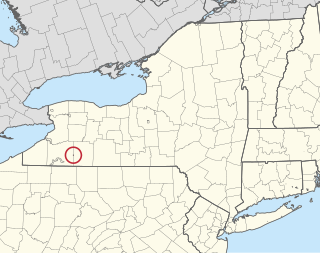
Oil Springs Reservation or Oil Spring Reservation is an Indian reservation of the federally recognized Seneca Nation that is located in southwestern New York, United States. As of the 2010 census, the Indian reservation had one resident; in 2005 no tribal members had lived on the property. The reservation covers about one square mile (2.6 km2), divided between the present-day counties of Allegany and Cattaraugus. The reservation is northwest of the village of Cuba. It is bordered by the Town of Cuba and the Town of Ischua.
The Seneca are a group of Indigenous Iroquoian-speaking people who historically lived south of Lake Ontario, one of the five Great Lakes in North America. Their nation was the farthest to the west within the Six Nations or Iroquois League (Haudenosaunee) in New York before the American Revolution. For this reason, they are called “The Keepers of the Western Door.”

The Holland Land Company was an unincorporated syndicate of thirteen Dutch investors from Amsterdam, headquartered in Philadelphia, who purchased large tracts of American land for development and speculation. Their primary purchase was that of the western two-thirds of the Phelps and Gorham Purchase in 1792 and 1793, an area that afterward was known as the Holland Purchase. Additional lands were purchased in northwest Pennsylvania. Aliens were forbidden from owning land within New York State, except by special acts of the New York State Legislature, so investors placed their funds in the hands of certain trustees who bought the land in central and western New York State. The syndicate hoped to sell the land rapidly at a great profit. Instead, for many years they were forced to make further investments in their purchase; surveying it, building roads, digging canals, to make it more attractive to settlers. They influenced state policy in New York to allow foreign ownership of the land, avoid new taxes, and promote the construction of the Erie Canal and government roads on the company lands. They supported Governor Dewitt Clinton's faction in the state government to achieve these goals. The company finished selling its New York lands in 1839 and its Pennsylvania lands in 1849, and the company was liquidated in 1858.

The Phelps and Gorham Purchase was the sale, in 1788, of a portion of a large tract of land in western New York State owned by the Seneca nation of the Iroquois Confederacy to a syndicate of land developers led by Oliver Phelps and Nathaniel Gorham. The larger tract of land is generally known as the "Genesee tract" and roughly encompasses all that portion of New York State west of Seneca Lake, consisting of about 6,000,000 acres (24,000 km2).
The Tonawanda Seneca Nation is a federally recognized tribe in the State of New York. They have maintained the traditional form of government led by sachems selected by clan mothers. The Seneca are one of the original Five Nations of the Haudenosaunee or Iroquois Confederacy. Their people speak the Seneca language, an Iroquoian language.
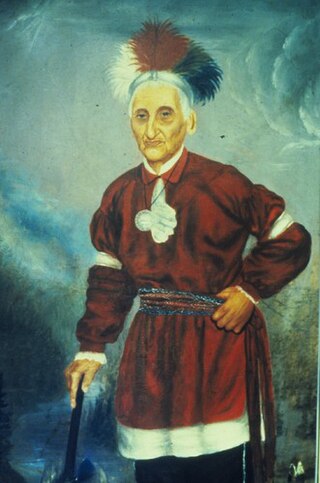
Tah-won-ne-ahs or Thaonawyuthe, known in English as either Chainbreaker to his own people or Governor Blacksnake to the European settlers, was a Seneca war chief and sachem. Along with other Iroquois war chiefs, he led warriors to fight on the side of the British during the American Revolutionary War from 1777 to 1783. He was prominent for his role at the Battle of Oriskany, in which the Loyalist and allied forces ambushed a force of Patriots. After the war, he supported his maternal uncle, Handsome Lake, as a prominent religious leader. Chainbreaker allied with the United States in the War of 1812 and later encouraged some accommodation to European-American settlers, allowing missionaries and teachers on the Seneca reservation.
Canawaugus was a Seneca Indian village. The village was located on the west side of the Genesee River, "about a mile above the ford", on the eastern edge of the Town of Caledonia. It was nearly opposite of the Avon sulphur springs. The name means "stinking waters" because of the sulphur.

The Buffalo Creek Reservation was a tract of land surrounding Buffalo Creek in the central portion of Erie County, New York. It contained approximately 49,920 acres (202.0 km2) of land and was set aside for the Seneca Nation following negotiations with the United States after the American Revolutionary War.
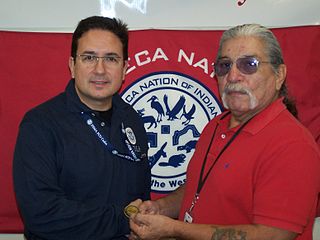
The Seneca Nation of Indians is a federally recognized Seneca tribe based in western New York. They are one of three federally recognized Seneca entities in the United States, the others being the Tonawanda Band of Seneca and the Seneca-Cayuga Nation of Oklahoma. Some Seneca also live with other Iroquois peoples on the Six Nations of the Grand River in Ontario.

The Seneca mission, sometimes called the Buffalo Creek mission, was a Christian mission to the Seneca people living in and around the Buffalo Creek Reservation in western New York. It was maintained, by several leaders and under the supervision of numerous missionary societies, from the early to mid-19th century. Some Seneca people accepted the mission; others, including Red Jacket and his followers, were strenuously opposed. Missionaries affiliated with the Seneca mission, including Asher Wright, transcribed the Seneca language into the Roman alphabet and printed Christian literature in Seneca.
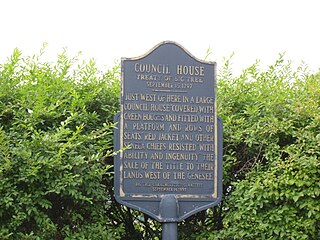
The Treaty of Big Tree was a formal treaty signed in 1797 between the Seneca Nation and the United States, in which the Seneca relinquished their rights to nearly all of their traditional homeland in New York State—nearly 3.5 million acres. In the 1788 Phelps and Gorham Purchase, the Haudenosaunee (Iroquois) had previously sold rights to their land between Seneca Lake and the Genesee River. The Treaty of Big Tree signed away their rights to all their territory west of the Genesee River except 12 small tracts of land for $100,000 and other considerations. The money was not paid directly to the tribe, but was to be invested in shares of the Bank of the United States, and to be paid out to the Senecas in annual earnings of up to six percent, or $6,000 a year, on the bank stock.
Seneca Nation of Indians v. Christy, 162 U.S. 283 (1896), was the first litigation of aboriginal title in the United States by a tribal plaintiff in the Supreme Court of the United States since Cherokee Nation v. Georgia (1831). It was the first such litigation by an indigenous plaintiff since Fellows v. Blacksmith (1857) and its companion case of New York ex rel. Cutler v. Dibble (1858). The New York courts held that the 1788 Phelps and Gorham Purchase did not violate the Nonintercourse Act, one of the provisions of which prohibits purchases of Indian lands without the approval of the federal government, and that the Seneca Nation of New York was barred by the state statute of limitations from challenging the transfer of title. The U.S. Supreme Court declined to review the merits of lower court ruling because of the adequate and independent state grounds doctrine.
Fellows v. Blacksmith, 60 U.S. 366 (1857), is a United States Supreme Court decision involving Native American law. John Blacksmith, a Tonawanda Seneca, sued agents of the Ogden Land Company for common law claims of trespass, assault, and battery after he was forcibly evicted from his sawmill by the Company's agents. The Court affirmed a judgement in Blacksmith's favor, notwithstanding the fact that the Seneca had executed an Indian removal treaty and the Company held the exclusive right to purchase to the land by virtue of an interstate compact ratified by Congress.

Aboriginal title in New York refers to treaties, purchases, laws and litigation associated with land titles of aboriginal peoples of New York, in particular, to dispossession of those lands by actions of European Americans. The European purchase of lands from indigenous populations dates back to the legendary Dutch purchase of Manhattan in 1626, "the most famous land transaction of all." More than any other state, New York disregarded the Confederation Congress Proclamation of 1783 and the follow-on Nonintercourse Acts, purchasing the majority of the state directly from the Iroquois nations without federal involvement or ratification.
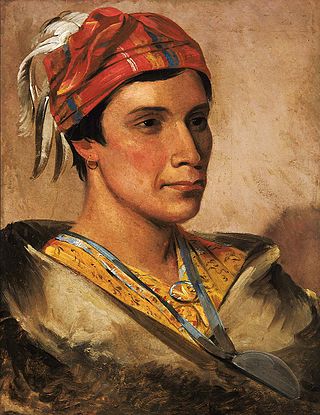
Daniel Bread was an Oneida political and cultural leader who helped the Oneida preserve their culture while adapting to new realities during their transplantation from New York to Wisconsin. He was frequently described as a "principal chief", "head chief", or "sachem" by the Oneida but held no hereditary position and was not an officially condoled chief. Bread was a pragmatist who found ways to compromise between "promoting tribal sovereignty and treaty rights" and cooperating with federal and state officials. He played a major role in adapting the Iroquois condolence ceremony into a July 4 celebration that recognized the alliance of the Oneida with George Washington during the American Revolution. At age 14, Bread was part of the defense of Sackets Harbor during the Battle of Big Sandy Creek.
The Third Treaty of Buffalo Creek or Treaty with the Seneca of 1842 signed by the U.S. and the Seneca Nation modified the Second Treaty of Buffalo Creek. This reflected that the Ogden Company had purchased only two of the four Seneca reservations, the Buffalo Creek and Tonawanda reservations, that the Senecas had agreed to sell in the Second Treaty; it thus restored native title to the Allegany, Cattaraugus and Oil Springs reservations.
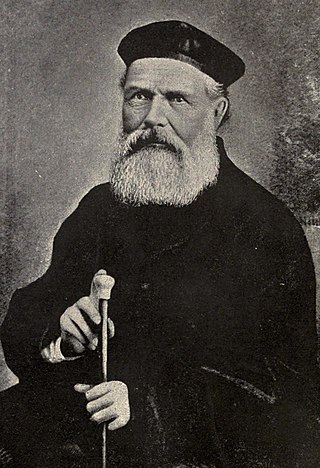
Asher Wright was an American Presbyterian missionary, who worked among the people of the Seneca Nation, of the native Iroquois of the northeastern United States from 1831 to 1875. His most notable work was the extensive translation and linguistics work he did among the Seneca people. Asher and his wife Laura Maria Sheldon were based in the Seneca mission on the Buffalo Creek Reservation. After 1845, they relocated along with the Buffalo Creek Seneca to the Cattaraugus Reservation following the sale of Buffalo Creek to developers from the Ogden Company. Alongside their missionary and ministry work, the Wrights recorded the Seneca language and culture. Integral to their work was the education of the Seneca people, especially teaching literacy to the people in their own language. In 1855 they founded the Thomas Asylum for Orphan and Destitute Children, later named the Thomas Indian School.

Maris Bryant Pierce, was a Seneca Nation chief, lawyer, and teacher. He was a tribal land-rights activist, and a major influence to the Second Treaty of Buffalo Creek of 1838.
References
- ↑ Red Jacket (Seneca chief) (2006). The Collected Speeches of Sagoyewatha, Or Red Jacket. Syracuse University Press. ISBN 9780815630968 . Retrieved May 8, 2017.
- ↑ Quigley, Kellen (December 31, 2022). "Seneca Nation purchases ancestral Genesee Valley land". The Salamanca Press . Retrieved 2022-12-31.
- ↑ Littlefield, Jr., Daniel F.; Parins, James W. (2011-01-19). Encyclopedia of American Indian Removal [2 volumes]. ABC-CLIO. p. 173. ISBN 978-0-313-36042-8.
- ↑ Johansen, Bruce Elliott; Mann, Barbara Alice (2000). Encyclopedia of the Haudenosaunee (Iroquois Confederacy). Greenwood Publishing Group. p. 249. ISBN 978-0-313-30880-2.
- ↑ Hauptman, Laurence (2008). Seven Generations of Iroquois Leadership: The Six Nations Since 1800. Syracuse University Press. ISBN 978-0-8156-3165-1.
- Laurence M. Hauptman, Conspiracy of Interests: Iroquois Dispossession and the Rise of New York State (2001).
- Encyclopedia of American Indian Removal. Santa Barbara, California: Greenwood. 2011. pp. 241–243. ISBN 978-0-313-36041-1.